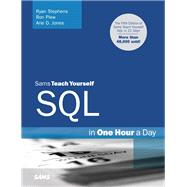
| Introduction | |
| Getting Started with SQL | |
| Introducing the Query | |
| Expressions, Conditions, and Operators | |
| Clauses in SQL Queries | |
| Joining Tables | |
| Embedding Subqueries into Queries | |
| Molding Data with Built-in Functions | |
| Database Design | |
| Database Normalization | |
| Creating and Maintaining Tables | |
| Controlling Data Integrity | |
| Data Manipulation | |
| Manipulating Data | |
| Dates and Time in SQL | |
| Creating Views | |
| Controlling Transactions Part 3 In Review | |
| Database Administration | |
| Creating Indexes on Tables to Improve Performance | |
| Streamlining SQL Statements for Improved Performance | |
| Database Security: Wanted | |
| Exploring the Data Dictionary (System Catalog) Part 4 in Review | |
| More SQL Objects | |
| Temporary Tables, Stored Procedures, Triggers, and Cursors | |
| New Objects in the Latest Standard Part 5 In Review | |
| Advanced SQL Programming | |
| Using SQL to Generate SQL Statements | |
| Creating Complex SQL Queries | |
| Debugging Your SQL Statements | |
| Embedding SQL in Application Programming Part 6 in Review | |
| SQL In Various Database Implementations | |
| Using Oracle SQL*Plus to Satisfy Reporting Needs | |
| An Introduction to Oracle PL/SQL | |
| An Introduction to Transact-SQL | |
| Using MySQL on a UNIX-based System Part 7 in Review | |
| Appendices | |
| Answers | |
| Code Examples to Create Tables | |
| Code Examples to Populate Tables | |
| Using MySQL for Exercises | |
| Glossary of Common SQL Commands | |
| Glossary of Common SQL Functions | |
| Sources for Further Information | |
| Table of Contents provided by Publisher. All Rights Reserved. |
The New copy of this book will include any supplemental materials advertised. Please check the title of the book to determine if it should include any access cards, study guides, lab manuals, CDs, etc.
The Used, Rental and eBook copies of this book are not guaranteed to include any supplemental materials. Typically, only the book itself is included. This is true even if the title states it includes any access cards, study guides, lab manuals, CDs, etc.